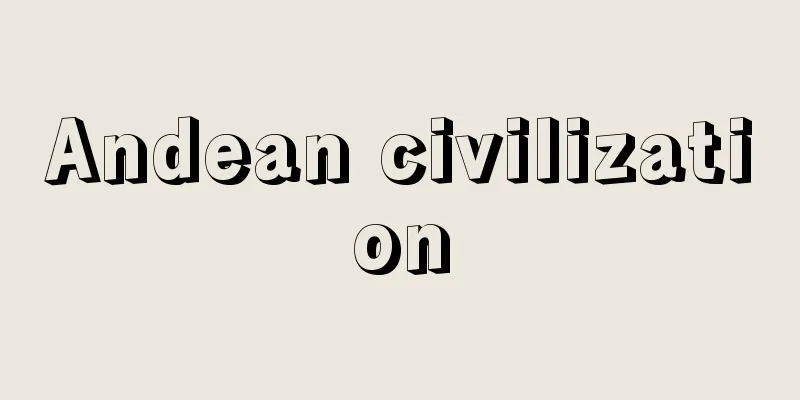Andean civilization

|
An ancient civilization that arose in the Andean highlands and adjacent coastal regions that run through western South America. It is often used to refer to the high culture that developed in what is now Peru and the western highlands of Bolivia. Along with Mesoamerican civilization, many of the most representative cultures of the ancient Americas rose and fell in this region. [Yoshiro Masuda] The beginning of settled lifeUnder the warming climate conditions of the postglacial period, from the end of the 7th millennium BC, two types of cultures began to develop on the coast and highlands of Peru. In the coastal areas, people who collected plants in coastal oases, taking advantage of the rich fishing resources of the Peruvian (Humboldt) Current, settled down and began cultivating gourds, beans, and other crops. Meanwhile, in the highlands, there is evidence that the domestication of camelids such as llamas and guinea pigs began at the latest in the 5th millennium BC. Along with these animals, the domestication of highland plants such as potatoes and quinoa also began. Exchanges took place between these two different cultures, and with the addition of cultivated plants such as cotton and corn, and pottery production techniques, intensive agriculture was established by the beginning of the 2nd millennium BC. Cotton in the Andes appeared in the 3rd millennium B.C., and maize in the middle of the 2nd millennium B.C. The latter was widely believed to have been introduced from Mesoamerica, but more recently it has been suggested that it may have been domesticated independently in the Andes. The pottery techniques are thought to have evolved from earlier pottery traditions among fishing peoples of Colombia and Ecuador that began around 3000 BC. The cultural influence of the tropical lowlands east of the Andes also contributed to the establishment of settled agriculture in the Andes, which has significance that cannot be ignored when tracing the origins of not only the cultivation of root vegetables such as manioc (yuca) and coca, but also the religious beliefs that regard jaguars, snakes, and caimans as sacred. [Yoshiro Masuda] Emergence of temple cultureIn the central Andes, the tendency to build large public buildings around settlements was evident even before the beginning of intensive agriculture and pottery production. One example is the Mito period "temple" of Cotos, Huánuco, early in the second millennium BC. Later, huge religious buildings made of adobe bricks appeared in coastal areas such as Las Aldas, El Paraíso, La Florida, and Garagay. Around 1000 BC, these religious trends were integrated into a pan-Andean religion centered on the temple of Chavin de Huantar, and the strong religious ideas centered on the worship of felines and snakes were expressed in stylized pottery and textile patterns and spread over a wide area. The Chavin culture spread across the northern and central coasts of Peru, as well as the highlands, but at the same time, it also influenced the Paracas culture on the southern coast, which had begun a tradition of unique painted pottery. There is also a strong view that the Chavin culture progressed with the spread of strong religious ideas and the formation of a pan-Andean political organization. [Yoshiro Masuda] Formation of the NationFrom the second half of the first millennium BC, the development of irrigation technology led to a dramatic increase in coastal arable land, and political conflicts began over water rights and arable land. Military territorial states emerged during this period, the most representative of which was the Moche (Motica) state on the north coast of Peru. The Nazca culture that emerged on the south coast around that time also likely contained several chiefdoms with strong ritual characteristics, as can be inferred from settlement ruins such as Cahuachi and Tambo Viejo. At the same time, a large temple city was established in Tiahuanaco on the shores of Lake Titicaca in Bolivia, and its cultural influence probably spread to southern and central Peru through pilgrimages and trade. Around 700 AD, a new culture strongly influenced by the Tiahuanaco culture emerged in the Wari of the central Peruvian highlands, and began to expand from there toward the north coast, while connecting with the Nazca region on the southern coast. In the highlands, the Wari influence penetrated into the Cayejon de Huaylas region and even reached the Cajamarca region. Thus, the Wari culture achieved a greater spatial expansion than the Chavin culture, but some scholars believe that behind this was a large-scale military conquest and the resulting establishment of an empire. [Yoshiro Masuda] Andean EmpireAfter 1000 AD, with the decline of the Wari culture, a tendency towards local political units and the revival of cultural traditions became evident. The Chimu on the north coast became a territorial state that controlled an area from Tumbes at the northern tip of Peru to the Chon River basin on the central coast, and powerful chiefdoms were also established in the Cañete, Chincha, Ica and other river basins on the south coast. Two tribes, the Huanca and Chanca, wielded power from the Mantaro River to the Apurimac River in the central highlands, but the Inca in the Cusco Basin, who had come into conflict with and defeated the Chanca, suddenly began military conquests in the early 15th century, and during the reign of Kings Pachacuti and Tupac Inca, they built a large state that extended over all of Peru, as well as Ecuador, Bolivia, northern Chile and northwestern Argentina. In the early 16th century, the Inca ruling class split between Cusco and Quito (Ecuador), starting a civil war, and shortly afterwards the Spanish invaded, putting an end to the long history of Andean civilization. [Yoshiro Masuda] "Andean Civilization" by L. G. Lumbreras, translated by Yoshiro Masuda (1977, Iwanami Shoten) [References] | | | | | |©Shogakukan "> The extent of the Andean civilization Source: Shogakukan Encyclopedia Nipponica About Encyclopedia Nipponica Information | Legend |
|
南アメリカ西部を縦走するアンデス山脈の高原および隣接した海岸地方に発生した古代文明。おもに、現ペルー、およびボリビア西部高地に発達した高文化をさすことが多い。メソアメリカ文明とともに、古代アメリカ大陸の代表的な諸文化がこの地域に興亡した。 [増田義郎] 定住生活の始まり後氷期の温暖化する気候条件のなかで、紀元前七千年紀末から、ペルーの海岸、高原地方で、二つの型の文化の発展が始まった。海岸地方においては、ペルー(フンボルト)海流の豊かな漁労資源を利用し、海岸のオアシス地帯で植物採集を行う人々が定住生活に入り、ヒョウタン、マメなどの栽培を始めた。一方、高原地方では、遅くとも前五千年紀には、ラクダ科のラマや、モルモットの家畜化が始まった証拠があり、それらの動物とともに、ジャガイモ、キノアなどの高地植物の栽培化が緒についた。この二つの系統の異なる文化の間に交流が行われ、さらにワタ、トウモロコシなどの栽培植物や土器制作の技術などが加わって、前二千年紀の初めには、集約農耕が成立した。 アンデスのワタは前三千年紀に、トウモロコシは前二千年紀のなかばに現れている。後者はメソアメリカからの伝播(でんぱ)という考え方が強かったが、最近ではアンデス地帯で独自に栽培化された可能性も論じられている。 土器制作技術は、前3000年ごろから始まった、コロンビアやエクアドルの漁労民の間での早期の土器制作の伝統から発しているものと考えられる。 また、アンデス地方の定住農耕の成立には、アンデス山脈の東側の熱帯低地の文化的影響も寄与している。それは、マニオク(ユカ)などの根菜やコカの栽培だけでなく、ジャガー、ヘビ、カイマンなどを神聖視する宗教観念の源泉をたどるときに、無視することのできない意味をもっている。 [増田義郎] 神殿文化の発生中央アンデスでは、集約農耕や土器制作が開始される以前から、集落をめぐって大きな公共建造物をつくる傾向が現れている。 前二千年紀初めのワヌコ県コトシュのミト期の「神殿」はその一例であるが、やがて海岸地方で、アドベ(日干し)れんがによる巨大な宗教建造物が、ラス・アルダス、エル・パライソ、ラ・フロリダ、ガラガイなどに発生する。前1000年前後から、これらの宗教的動向は、チャビン・デ・ワンタル神殿を中心とした汎(はん)アンデス的な宗教に統合され、ネコ科の動物やヘビなどの崇拝を中心とした強力な宗教観念の表象が、様式化された土器、織物の文様に表されて、広い地域に広がった。チャビン文化の広がりは、ペルーの北・中海岸、および高地にまたがるが、同時に、個性的な彩色土器の伝統を開始していた南海岸のパラカス文化にもその影響は及んでいる。チャビン文化は、強烈な宗教観念の伝播と同時に、汎アンデス的な政治組織の編成を伴って進行した、という考え方も強い。 [増田義郎] 国家の形成前一千年紀の後半から、灌漑(かんがい)技術の発達によって海岸耕地が飛躍的に増大し、その水利権や耕地をめぐって、政治的紛争が始まった。軍事的な領土国家がこの時期に出現したが、その代表的なものは、ペルー北海岸のモチェ(モティーカ)の国家であった。そのころ南海岸に興ったナスカ文化も、祭祀(さいし)的性格を強くもったいくつかの首長制社会を内蔵していたらしいことは、カワチ、タンボ・ビエホなどの集落遺跡から推測できる。 同じころ高原では、ボリビア、ティティカカ湖畔のティアワナコに、大神殿都市が発生し、おそらく巡礼や通商によって、その文化的影響がペルー南部、中部にまで及んでいたらしい。紀元後700年前後に、ペルー中部高原のワリに、ティアワナコ文化の影響を強く受けた新しい文化が興り、南海岸のナスカ地方と連絡をもちながら、そこから北海岸に向かって拡大し始めた。高原地方では、ワリの影響はカイエホン・デ・ワイラス地方に浸透し、さらにカハマルカ地方にも及んだ。こうしてワリ文化は、チャビン文化より大きな空間的拡大を達成したが、その背後に、大規模な軍事征服と、その結果としての帝国の成立を考える学者もいる。 [増田義郎] アンデス帝国紀元1000年以後、ワリ文化の衰退に伴って、地方的な政治単位と文化伝統復活の傾向が顕著になった。北海岸のチムーは、ペルー北端のトゥンベスから中部海岸のチョン川流域までを制する領土国家となり、南海岸のカニェテ、チンチャ、イカなどの流域にも、強力な首長制社会が成立した。中部高原のマンタロ川からアプリマク川にかけては、ワンカ、チャンカの2部族が勢力を振るったが、チャンカと対立してこれを撃破したクスコ盆地のインカ人が、15世紀初めから急に軍事征服を開始し、パチャクティ、トゥパク・インカ両王の時代に、ペルー全土およびエクアドル、ボリビア、北部チリ、北西アルゼンチンにわたる大国家を建設した。16世紀初め、インカの支配階層が、クスコとキト(エクアドル)に二分して内乱が開始された直後にスペイン人が侵入、長いアンデス文明の歴史に終止符が打たれた。 [増田義郎] 『L・G・ルンブレラス著、増田義郎訳『アンデス文明』(1977・岩波書店)』 [参照項目] | | | | | |©Shogakukan"> アンデス文明がおよんだ範囲 出典 小学館 日本大百科全書(ニッポニカ)日本大百科全書(ニッポニカ)について 情報 | 凡例 |
<<: Antenna - Antenna (English spelling)
Recommend
PAR - Partial Apparent
Abbreviation for 4-(2-pyridylazo)resorcinol. C 11...
Estado Novo (English spelling)
…Vargas was immediately elected as the official p...
Syndromic
Atactic polymers have completely different proper...
Related words - Engo
〘noun〙 A rhetorical device used in waka poetry and...
Local contraction - Local contraction
…In the case of tensile tests, the parallel part ...
Famagusta (English spelling)
Ammókhostos in Greek, Magusa in Turkish. A city on...
Kron, G. (English spelling) KronG
... Although there are some records of performanc...
Kai's Handshake - Kai's Handshake
...Late geographical works include Noda Shigekata...
Emilia sonchifolia (L.) DC.
An annual plant of the Asteraceae family (illustra...
Colorful Birds
〘Noun〙① Various small birds. Especially the variou...
Tadashi Iwamoto
1869-1941 A philosopher from the Meiji to early S...
Mongolian gerbil (sand rat)
A rodent mammal of the Muridae family and the Gerb...
Lyric poetry
The word originates from the ancient Greek lyra, a...
Lure fishing - Lure fishing (English spelling)
The word "lure" is used to mean to lure...
Labor Dispatch Business Law - ろどそうはケンギン学法
This law is concerned with ensuring the proper ope...









